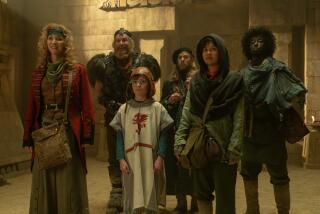A Flight to Remember
- Share via
Sci-fi writer Douglas Adams wants everyone to know that his new computer game, “Starship Titanic,” was not released to cash in on the biggest box-office movie of all time. The game’s development even predates the movie’s, according to Adams.
“It’s a nuisance, to be honest,” Adams said. “I shouldn’t complain, but I feel slightly hijacked, because the title refers to a semi-mythical event from the beginning of the century. Then suddenly there’s a vast gargantuan movie that’s in everyone’s minds. It surprises me when people say, ‘You brought this out to capitalize on “Titanic.” ’ You can’t suddenly put a game together in just a month.”
The game was in development for more than two years before its recent release and focuses on a wacky spaceship of the future, rather than a love affair of the past. Adams, known for authoring the classic “The Hitchhiker’s Guide to the Galaxy” novel in 1979 and follow-ups through the ‘80s and ‘90s, actually created an early text-based “Hitchhiker” game more than 10 years ago.
Now 46, the quirky British author is co-founder of London-based Digital Village, a company dedicated to fulfilling Adams’ visions through games, television, movies and the Web. “Starship Titanic” is the first fruit of their labor, published by Simon & Schuster Interactive, and requiring a 100 MHz Pentium computer, Windows 95 and 160 megabytes of hard disk space. (A Mac version is in the works.)
The $48 game could simplistically be described as “Monty Python meets Myst,” an immersion adventure game that actually employs Python’s John Cleese and Terry Jones with voice-overs as a bomb and a parrot, respectively. The massive spaceship has crashed into your home, and you climb aboard for an otherworldly space voyage with a crew of malcontent robots.
The game’s look, produced by Oscar-winning designers Oscar Chichoni and Isabel Molina (“Restoration”), shows just how Space Age the Art Deco era was. The combination of sleek, layered metallic lines and vast elevator shafts and halls is magnificent, bringing to mind ‘30s style in a futuristic world.
Still, the main draw of the game consists of the many ‘bots with whom you converse. The Bell Bot, for instance, has a head that doubles as the bell you ring at the front desk. You can chat (by typing text) for hours with her, getting snide retorts or precious hints. There are 16 hours of recorded dialogue, but if you repeat questions enough, you’ll hear repeated answers.
The biggest downside to the game is the lack of direction. According to Adams, “you become gripped by one of the most powerful forces known to modern man, which is the desire for the free upgrade.” After a few hours of playing, you may find that simply wandering around and making small talk with the ‘bots is more enjoyable than any goal. But their circular talk and cheeky jokes can wear thin in time.
Adams says he wasn’t aiming for the traditional computer gaming audience.
“To be honest, what I’d really love is to get a wider audience that doesn’t usually play games,” he said. “ ‘The Hitchhiker’s Guide’ reached a wider audience that didn’t normally like science fiction. This is for people who don’t like games. You don’t have to rip anyone’s head off. It’s very much aimed at the non-psychopath audience.”
Adams estimates that the people who have bought the game so far have only experienced 20% of the dialogue. He wants to encourage players to take their time and chat up the ‘bots. The game’s programmers, who created an original engine for the game, used elaborate “pattern matching” to make dialogue more realistic. When you type something in, the language engine looks for a subject, object and verb, and searches for an appropriate response.
The random nature of the ‘bots makes them more like real children than static characters in a book, according to Adams. When he tries to get them to respond a certain way while showing the game to reviewers, he’s frustrated because “you can’t get them to say what you want them to say, just like children.”
Adams is beginning to get a script together for a film version of “The Hitchhiker’s Guide to the Galaxy” with Jay Roach (“Austin Powers”) slated to direct. The film is targeted for release in summer 2000, and Adams anticipates writing a “long-overdue” novel by next spring. Digital Village, meanwhile, has grandiose plans for a Web guide that mimics “The Hitchhiker’s Guide.”
There’s already a Terry Jones novel based on “Starship Titanic,” but Adams won’t rule out a movie as well. Just don’t expect Leonardo DiCaprio to star.
* Mark Glaser is a San Francisco-based freelance writer and critic who writes the Cybertainment column for Calendar Weekend. You can reach him at glaze@sprintmail.com.
More to Read
The biggest entertainment stories
Get our big stories about Hollywood, film, television, music, arts, culture and more right in your inbox as soon as they publish.
You may occasionally receive promotional content from the Los Angeles Times.










